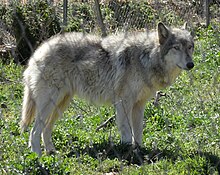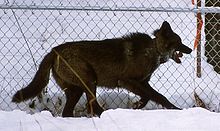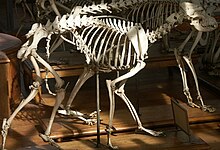
The coyote is a species of canine native to North America. It is smaller than its close relative, the wolf, and slightly smaller than the closely related eastern wolf and red wolf. It fills much of the same ecological niche as the golden jackal does in Eurasia. The coyote is larger and more predatory and was once referred to as the American jackal by a behavioral ecologist. Other historical names for the species include the prairie wolf and the brush wolf.

Canidae is a biological family of dog-like carnivorans, colloquially referred to as dogs, and constitutes a clade. A member of this family is also called a canid. The family includes three subfamilies: the extant Caninae and the extinct Borophaginae and Hesperocyoninae. The Caninae are known as canines, and include domestic dogs, wolves, coyotes, foxes, jackals and other extant and extinct species.
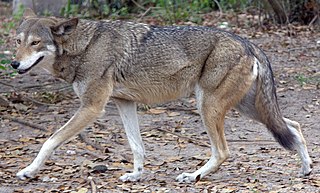
The red wolf is a canine native to the southeastern United States. Its size is intermediate between the coyote and gray wolf.

The wolf, also known as the gray wolf or grey wolf, is a large canine native to Eurasia and North America. More than thirty subspecies of Canis lupus have been recognized, including the dog and dingo, though gray wolves, as popularly understood, only comprise naturally-occurring wild subspecies. The wolf is the largest extant member of the family Canidae, and is further distinguished from other Canis species by its less pointed ears and muzzle, as well as a shorter torso and a longer tail. The wolf is nonetheless related closely enough to smaller Canis species, such as the coyote and the golden jackal, to produce fertile hybrids with them. The wolf's fur is usually mottled white, brown, gray, and black, although subspecies in the arctic region may be nearly all white.

Canis is a genus of the Caninae which includes multiple extant species, such as wolves, dogs, coyotes, and golden jackals. Species of this genus are distinguished by their moderate to large size, their massive, well-developed skulls and dentition, long legs, and comparatively short ears and tails.

The Saarloos Wolfdog is a wolf-dog breed originating from the Netherlands by the crossing of a German Shepherd with a Siberian grey wolf in 1935. The offspring were then further crossed with German Shepherds.

The eastern wolf also known as the timber wolf, Algonquin wolf or eastern timber wolf, is a canine of debated taxonomy native to the Great Lakes region and southeastern Canada. It is considered to be either a unique subspecies of gray wolf or red wolf or a separate species from both. Many studies have found the eastern wolf to be the product of ancient and recent genetic admixture between the gray wolf and the coyote, while other studies have found some or all populations of the eastern wolf, as well as coyotes, originally separated from a common ancestor with the wolf over 1 million years ago and that these populations of the eastern wolf may be the same species as or a closely related species to the red wolf of the Southeastern United States. Regardless of its status, it is regarded as unique and therefore worthy of conservation with Canada citing the population in eastern Canada as being the eastern wolf population subject to protection.

The golden jackal, also called common jackal, is a wolf-like canid that is native to Eurasia. The golden jackal's coat varies in color from a pale creamy yellow in summer to a dark tawny beige in winter. It is smaller and has shorter legs, a shorter tail, a more elongated torso, a less-prominent forehead, and a narrower and more pointed muzzle than the Arabian wolf. It is listed as Least Concern on the IUCN Red List due to its widespread distribution and high density in areas with plenty of available food and optimum shelter.

A coydog is a canid hybrid resulting from a mating between a male coyote and a female dog. Hybrids of both sexes are fertile and can be successfully bred through for generations. Similarly, a dogote is a hybrid with a dog father and a coyote mother.

Coywolf is an informal term for a canid hybrid descended from coyotes, eastern wolves, gray wolves, and dogs. All members of the genus Canis are closely genetically related with 78 chromosomes and therefore can interbreed. One genetic study indicates that these two species genetically diverged relatively recently. Genomic studies indicate that nearly all North American gray wolf populations possess some degree of admixture with coyotes following a geographic cline, with the lowest levels occurring in Alaska, and the highest in Ontario and Quebec, as well as Atlantic Canada. Another term for these hybrids is sometimes wolfote.
Canid hybrids are the result of interbreeding between the species of the subfamily Caninae.

The CzechoslovakianWolfdog is a breed of wolfdog that began as an experiment conducted in Czechoslovakia in 1955. The breed was known as Czech Wolfdog until 1982.

The domestication of the dog was the process which created the domestic dog. This included the dog's genetic divergence from the wolf, its domestication, and the emergence of the first dogs. Genetic studies suggest that all ancient and modern dogs share a common ancestry and descended from an ancient, now-extinct wolf population – or closely related wolf populations – which was distinct from the modern wolf lineage. The dog's similarity to the grey wolf is the result of substantial dog-into-wolf gene flow, with the modern grey wolf being the dog's nearest living relative. An extinct Late Pleistocene wolf may have been the ancestor of the dog.

Dog behavior is the internally coordinated responses of individuals or groups of domestic dogs to internal and external stimuli. It has been shaped by millennia of contact with humans and their lifestyles. As a result of this physical and social evolution, dogs have acquired the ability to understand and communicate with humans. Behavioral scientists have uncovered a wide range of social-cognitive abilities in domestic dogs.
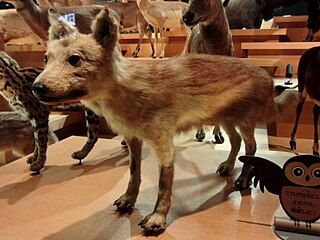
The Japanese wolf, also known as the Honshū wolf, is an extinct subspecies of the gray wolf that was once endemic to the islands of Honshū, Shikoku and Kyūshū in the Japanese archipelago.

A black wolf is a melanistic colour variant of the gray wolf. Black specimens were recorded among red wolves, though the colour morph in this species is probably now extinct. Genetic research from the Stanford University School of Medicine and the University of California, Los Angeles revealed that wolves with black pelts owe their distinctive coloration to a mutation which occurred in domestic dogs, and was carried to wolves through wolf-dog hybridization. Besides coat and knee colour, they are normal grey wolves.
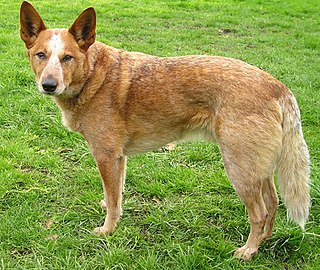
A dingo–dog hybrid is a hybrid cross between a dingo and a domestic dog. The current population of free ranging domestic dogs in Australia is probably higher than in the past. However, the proportion of the so-called "pure" dingoes has been on the decrease over the last few decades due to hybridisation and is regarded as further decreasing.

The eastern coyote is a wild North American canine hybrid with both coyote and wolf parentage. The hybridization likely first occurred in the Great Lakes region, as western coyotes moved east. It was first noticed during the early 1930s to the late 1940s, and likely originated in the aftermath of the extirpation of the gray wolf and eastern wolf in southeastern Ontario, Labrador and Quebec, thus allowing coyotes to colonize the former wolf ranges, and mix with the remnant wolf populations. This hybrid is smaller than the eastern wolf and holds smaller territories, but is larger and holds more extensive home ranges than the typical western coyote.

A jackal–dog hybrid is a canid hybrid resulting from a mating between a domestic dog and a golden jackal. Such crossbreeding has occurred numerous times in captivity and was first confirmed to occasionally happen in the wild in Croatia in 2015.

The evolution of the wolf occurred over a geologic time scale of at least 300 thousand years. The grey wolf Canis lupus is a highly adaptable species that is able to exist in a range of environments and which possesses a wide distribution across the Holarctic. Studies of modern grey wolves have identified distinct sub-populations that live in close proximity to each other. This variation in sub-populations is closely linked to differences in habitat – precipitation, temperature, vegetation, and prey specialization – which affect cranio-dental plasticity.
